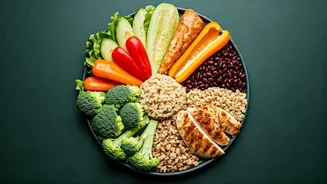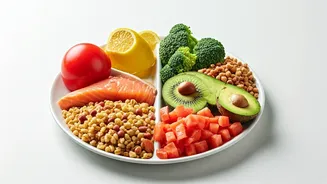Plate's Foundation: Fruits, Veggies
The cornerstone of Harvard's healthy eating plate is the generous inclusion of fruits and vegetables. Half of your plate should be filled with these vibrant
foods. Prioritize a wide variety of colors, as each hue signifies different vitamins, minerals, and antioxidants. These are essential for overall health, immunity, and disease prevention. Fruits and vegetables are low in calories and high in fiber, contributing to weight management and digestive health. Choose fresh, frozen, or canned options without added sugars or sodium. Embrace seasonal produce to enjoy the freshest flavors and the greatest nutrient density. For instance, consider a colorful salad of leafy greens, bell peppers, and berries, or roasted vegetables as a side dish.
Grains: The Quarter
Whole grains should occupy about a quarter of your plate according to Harvard's guidelines. These include foods like brown rice, whole-wheat pasta, quinoa, and oats. Unlike refined grains (white bread, white rice), whole grains retain their bran and germ, which are rich in fiber, vitamins, and minerals. Fiber aids in digestion, helps regulate blood sugar levels, and keeps you feeling full. Opt for whole-grain options whenever possible, such as whole-wheat bread instead of white bread, and brown rice instead of white rice. Read food labels carefully to ensure that the first ingredient listed is a whole grain. Try incorporating whole grains into your breakfast by having oatmeal, or include quinoa in your lunch or dinner.
Healthy Proteins Explained
Another quarter of the plate should be dedicated to healthy protein sources. The focus is on lean proteins, which include fish, poultry, beans, and nuts. These foods provide the essential amino acids your body needs for building and repairing tissues. Fish, particularly fatty fish like salmon, are rich in omega-3 fatty acids, which support heart and brain health. Choose skinless poultry and lean cuts of meat. Beans and legumes are excellent plant-based protein sources, offering fiber and various nutrients. Nuts and seeds can be included in moderation. Avoid processed meats, which are often high in sodium and unhealthy fats. Plan your meals to include a protein source at each meal, like grilled chicken breast, a serving of lentils or a handful of almonds.
Healthy Oils: Moderate Usage
Harvard’s healthy eating plate also emphasizes healthy oils, which should be used in moderation. The guide suggests using healthy oils like olive oil, canola oil, and other plant-based oils for cooking and dressing salads. These oils provide essential fatty acids and can contribute to heart health. It's important to keep portion sizes in check, as all oils are calorie-dense. Avoid trans fats, which are found in some processed foods and can increase your risk of heart disease. Choose unsaturated fats over saturated fats. Use oils for cooking and salads, and try to incorporate healthy fats from sources like avocados and nuts in your diet.
Hydration: Choose Wisely
Beverages play a crucial role, and Harvard's plate encourages smart choices. Water should be the primary beverage. It's essential for hydration and numerous bodily functions. Other healthy choices include coffee and tea, consumed without added sugar. Limiting sugary drinks is important because they contribute extra calories without providing nutritional value. Avoid sugary drinks like soda, sweetened juices, and energy drinks. Instead, make water your go-to beverage throughout the day. You can add fruit slices, cucumber, or mint to add flavor to your water.
Stay Active for Wellness
Physical activity is a key component of overall wellness and complements healthy eating. The eating plate encourages regular exercise for weight management and optimal health. It is suggested to incorporate at least 30 minutes of moderate-intensity exercise most days of the week. This includes activities like brisk walking, cycling, or swimming. Regular exercise helps improve cardiovascular health, boost metabolism, and enhance mood. Find activities you enjoy, so that exercise becomes a regular and enjoyable part of your routine. Combine your balanced diet with consistent activity for sustainable health benefits. Making exercise a part of your daily life will boost your physical and mental health.











